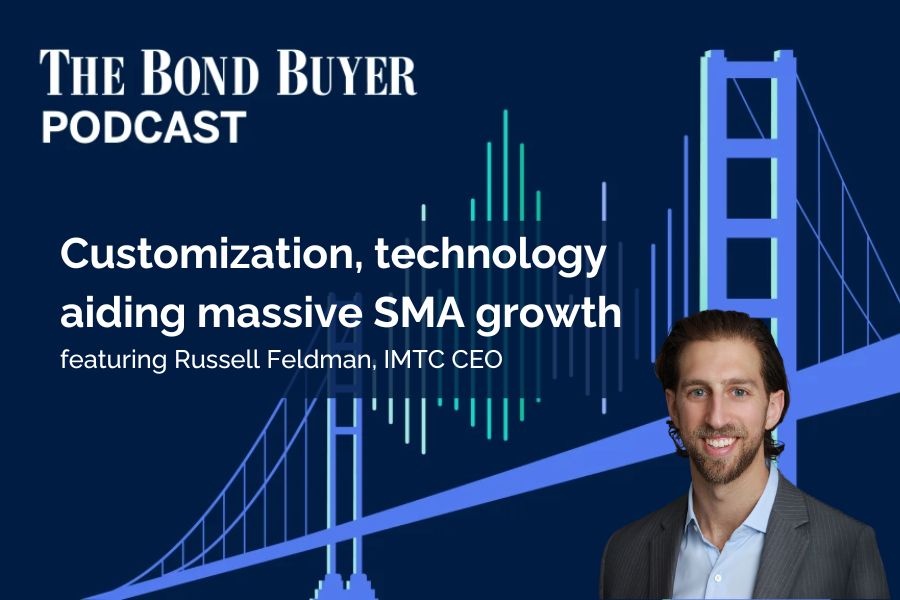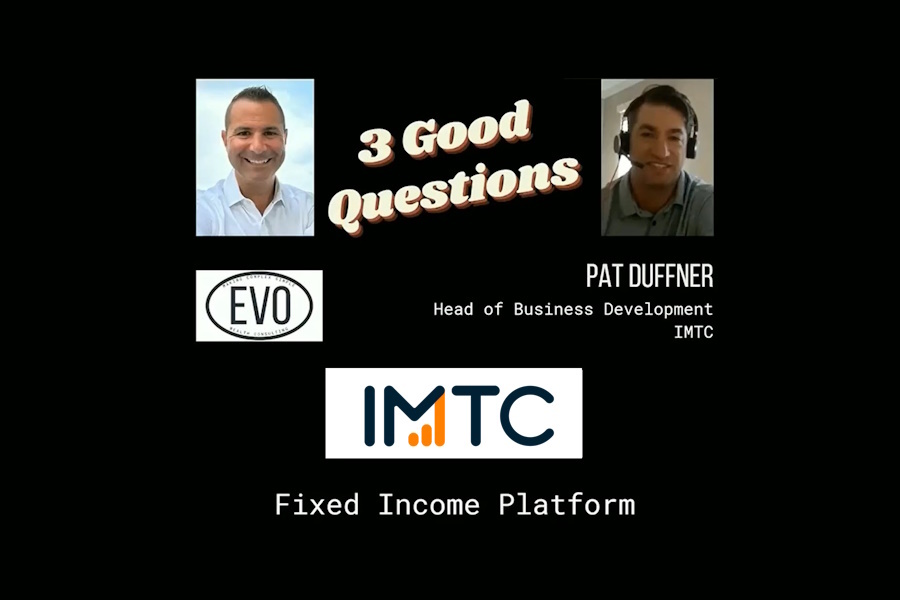IMTC CEO Russell Feldman featured on The Bond Buyer Podcast

This week, IMTC’s CEO Russell Feldman sat down with Lynne Funk on The Bond Buyer Podcast about the massive growth of SMAs in the muni sector and how technology is aiding that growth.
This podcast offers valuable insights into how technology can transform fixed income portfolio management, making it a must-listen for professionals looking to enhance their strategies and stay competitive in the industry.
Listen to The Bond Buyer Podcast below or wherever you get your podcasts!
In this episode, Russell and Lynne discuss SMA growth and technology
This podcast conversation provides valuable insights into the growth of SMAs, the demand for customization, and the pivotal role of technology in modernizing fixed income portfolio management for enhancing client outcomes. Key topics include:
- Separately Managed Account (SMA) growth in the municipal finance space has been fueled by factors like higher yields, lower fees, demand for customization, and improved technology.
- SMAs enable firms to offer enhanced customization capabilities, individual ownership of securities, tax advantages, and tailored investment outcomes.
- Technology has been key in supporting the management of highly customized portfolios; cloud technology, automation, integrated systems, and data-driven insights enable firms to efficiently handle large volumes of accounts and make decisions at scale.
Podcast Transcript
Mike Scarchilli (00:00):
Hi everyone and welcome to the Bond Buyer Podcast. I’m Mike Scarchilli, Editor-In-Chief of The Bond Buyer. And this week we’ll be debuting a new format for the podcast, while it will still feature in-depth insightful conversations between our reporters and editors and thought leaders from across the municipal finance spectrum. Each episode will begin and end with comments and context from me both introducing and wrapping up the topic of conversation. On today’s episode, we’re going to be discussing separately managed accounts in the municipal finance space. An area that’s seen vast amounts of capital infusion recently spurred on by higher yields, lower fees, the desire for deeper customization along with improvements in technology. This is just the latest in an ongoing trend of accelerated growth in this area. As participants on the street estimate that SMA hold somewhere between $1 trillion to $1.5 trillion of municipal bonds up massively from an estimated $100 billion before the 2007-2008 financial crisis.
(01:00)
To discuss this topic with us, our guest today is Russell Feldman, CEO and co-founder of IMTC, an end-to-end fixed income portfolio and order management system. Prior to launching the firm in 2017, Russell worked in institutional sales and client advisory at Deutsche Asset Management, serving clients across a broad array of investment products. Russell was also a member of the Bond Buyer’s 2022 class of rising stars of municipal finance. And at the time, IMTC’s president said Russell’s strategic vision laser focus on execution and authenticity and coaching a team all enabled him to become the CEO of a disruptive tech company before turning 35. With that, let’s listen in on the recent conversation between Russell Feldman and our executive editor, Lynne Funk.
Lynne Funk (01:50):
So there’s a lot to discuss today with you and the main focus of what I would like to talk about with you is separately managed account growth and SMAs in general. But before we get there, perhaps you could give our listeners a little more background on IMTC, how you came to format, what it is you do broadly before we get into some more of the meat of the topic.
Russell Feldman (02:13):
Yeah, terrific. Well, thank you again. I’m excited to be here and look forward to talking through this with you. As you rightly pointed out, IMTC was a direct result of my time at Deutsche. Our PM team was managing insurance and institutional portfolios and SMAs. We had lots of legacy systems and yet spent most of the time doing so in Excel. Eventually it became clear that we needed a system that was workflow focused that brought automation to the equation and that enabled customization at scale. And so we set out to build a platform buy and for the people in this case, fixed income portfolio managers and traders that would essentially enable the levels of personalization that are required in order to be successful in this day and age in the SMA space. And now we’re lucky to service asset and wealth managers, RIAs home offices using the technology that we built that’s really focused on the end-to-end connectivity of everything from portfolio construction all the way through into execution and post-trade settlement and looking to deliver automation and optimization along the way.
Lynne Funk (03:25):
You’re creating in IMTC in 2017 predates some of this truly massive growth of SMAs in the most recent years. And I kind of help but wonder, did you see the writing on the wall back then? But let’s start with SMAs. Let’s start with the massive growth of them in fixed income generally and the muni market specifically. Some on the street have Muni, SMA holdings as much as one and a half trillion. Others put it more conservatively to 1 trillion, but regardless, that’s pretty staggering numbers compared to just a few years ago. So can you just talk about what are you seeing there? What is driving this growth?
Russell Feldman (04:05):
Yeah, absolutely. And like you said, over the last two years we’ve seen SMA grow over 20% a year. Well, mutual funds ETFs have declined meaningfully by over I think 10% or so in the same period. I think there’s a couple big factors. The first one surely has a lot to do with interest rates that’s driven a lot of retail investors to increase fixed income allocations. T-bills moving from eight basis points to 5.5% certainly has had a meaningful impact. I also think the growth can be attributed to reduction in account minimums. These were as high as anywhere from 1 million to 3 million a decade ago, and now we’re commonly seeing SMAs offered for one 50 to two and a quarter or so, and that’s obviously a meaningful difference. Ultimately, desire for customization and the need for or investors desire to move away from the aggressive, moderate conservative buckets that they were previously dropped into, I think has also led to an explosion really in the desire for these types of accounts that lend themselves to customization.
Lynne Funk (05:19):
Okay. So customization, you’ve seen a substantial growth for custom s MAs, and could you had to explain that in the investment wrapper and why it’s benefiting firms?
Russell Feldman (05:33):
Definitely. As far as SMAs go, these are investment strategies where the end client owns the individual stock or bond in their portfolio. It provides the opportunity for customization, which differs from the more one size fits all mutual fund or ETF. And owning the underlying securities allows managers to take advantage of tax and harvest losses, which ultimately can be offset against gains to lower the client’s tax liability. So from a wrapper standpoint, that’s the key benefit to the end user. For the last several years, I think passive investing has really been all the rage, but I think now customization is usurped passive as the hot topic. People are really excited about the returns in this space and now they’re very eager to personalize their outcomes. We share the opinion of our clients in that all bond investors should have the power to tailor their fixed income allocations to suit the end clients’ specific needs and preferences.
(06:35)
There are some tier one asset managers that consider as much as 40% of their SMAs to be custom portfolios at this time. And in my mind that customization is one of the key selling points to an SMA vehicle in general as far as the benefits that firms are achieving. We’re seeing that customization is leading to clients paying up to three x what they would pay for a traditional bond ladder. And so there’s certainly a desire from a firm standpoint to be able to offer these types of customized solutions. And I think in general, the desire to do right by the end client coupled with the advancements that have been made in technology and scalability, those are reasons why we would expect to see the percentage of custom SMAs continue to increase in the short and medium term.
Lynne Funk (07:30):
Can you talk more about the new technology and the innovations for growing firms businesses? What are some of the factors they’re considering and how much has technology driven all of this growth?
Russell Feldman (07:43):
Yeah, well, as I was mentioning, I think it’s certainly great to get paid more for customization. I think the onus is now on the asset manager to ensure that they have the technological and operational infrastructure to support managing hundreds or thousands of highly customized portfolios. PMs need to be able to consider all of the unique cash needs, compliance restrictions, individual preferences, et cetera, of every single portfolio they manage. It would really be impossible to go account by account to determine those that require attention and the exact action that they need. And so in thinking about that, cloud technology is a really important consideration in that regard. As a cloud native solution ourselves, we’re getting more and more asset managers coming to us with desires of scale. So I think they’re realizing that legacy technology and the in-house technology they may have built 10 years ago didn’t really consider the possibility that they could be managing 10,000 or 25,000 accounts simultaneously.
(08:50)
And so I think that’s certainly an important factor. I also think delivering better returns is a critical component of why people are looking to technology. Differentiation is still really important in this field and the ability to leverage technology that, for example, is able to target odd lot matches where there’s a ton of value in the market or you’re able to get portfolios invested more quickly, buying treasuries on day one and then rolling into munis over time. These are kind of more efficient and improved ways to handle portfolios and to ultimately deliver better outcomes to the client.
Lynne Funk (09:26):
Lets go back what you mentioned earlier, account minimums. How has technology really been able to lower account minimums or has it? I guess that’s the question.
Russell Feldman (09:38):
Yeah, it certainly has, and I think as we were just talking about making customized decisions at scale is what enables a lower account minimum. You can manage 10 portfolios at a million a pop, but how many portfolios can you manage at a hundred thousand market value? And the question really becomes how much time is a given portfolio manager spending on each portfolio? And so for us, it’s about giving the portfolio managers the confidence to leverage our technology or technology in general to make decisions at scale. So I can’t speak to how other folks are doing it, but on our system we’ve launched a proprietary portfolio optimization tool that ingests tens of millions of data points every single day, everything from tax lots to cash needs to live inventory, CRM, data compliance rules, et cetera. And then we’re using all of that data to assist the client in their decision making frankly, and to deliver highly practical buys and sells at the CUSIP level across portfolios simultaneously. All that is to say we’re enabling these clients to say we are comfortable managing thousands of accounts with smaller minimums because we know that the system can help generate optimal allocations across portfolios without us having to go portfolio by portfolio to determine the needs and the outcomes.
Lynne Funk (11:11):
So when we’re talking about all this dramatic growth in SMAs, I want to just go back to a second to the mutual fund complex so far in 2024, seen a mix of inflows, outflows, but the question I have is, do mutual funds still play as much of a role, have as much of clout, will they ever return to what they were before as have SMA and ETFs frankly come into this space more permanently?
Russell Feldman (11:41):
I definitely think this is a more permanent change. I think that mutual funds will continue to exist and they continue to be an important vehicle, but I do believe strongly that SMAs and even now UMass are coming into the fray in a much more prevalent fashion. And I think there’s a couple of different ways though that mutual funds and ETFs are still being utilized in the context of client portfolios and we can certainly get into that if it’s of interest.
Lynne Funk (12:20):
Absolutely. I’d love to hear some more of your thoughts on that.
Russell Feldman (12:24):
So I think for starters, I think there are a couple of different ways in which we’re seeing clients layer in funds in the context of SMA portfolios, for starters, these alpha overlay strategies where they’re buying a fund and then they’re layering individual names on top of the fund to generate alpha for the portfolio. But also what we’re working on with some clients is a look throughs directly into the mutual fund such that we’re able to deliver the client the actual underlying risk of a portfolio that has multiple different asset types. So if there are allocations to a given issuer or security in that mutual fund and also in the SMA, we’re representing the entirety of that allocation and that risk in the context of an optimization that’s being run. And so I think those are kind of interesting opportunities. And then I think about direct indexing and custom indexing being another topic that certainly we can delve into that I think has a lot to do with leveraging funds in the context of SMAs.
Lynne Funk (13:30):
Well, you read my mind, I think because I was about to ask you about leveraging director custom indexing and fixed income and how you see firms doing that.
Russell Feldman (13:39):
Yeah, I think it starts with the end client’s desire for that type of exposure or exposure that mirrors or replicates or resembles an index or a fund, and then it’s incumbent upon the investment team to determine how they want to do that. When we think about doing that at scale, that’s obviously where technology comes into play. So clients taking clients of ours are leveraging the platform to codify rules relative to an index. So that could be issuer, state percentages, callability ratings, large sub-sectors like housing or education, and then building the SMAs and the portfolios to tie back to those characteristics or relative to those characteristics. And so once we’ve matched all of the risk metrics within a given tolerance, then they look to outperform in the context of after tax yields or let’s say just say maximization of an objective, which oftentimes in the muni space is maximizing a taxable equivalent yield.
(14:49)
I want to just add that we’re going to go as far on our platform, and I’m sure this will come up in other places as well as to offer the customization of those indices directly to the end user. So our clients and clients will have the ability to experience a level of customization that really hasn’t been possible in the fixed income space in the past. Whereas in equities end users can say, we want the s and p 500 with double tesla and clean energy, and they snap their fingers and they get that basket. So too, should it be possible in the fixed income markets so long as you have the necessary data and ultimately data aggregation and then optimization around that information to deliver results in real time.
Lynne Funk (15:38):
So I would like to ask you a little bit about how you all work with credit risk. We’re coming on off of a couple years of some pretty substantial federal aid for issuers and maybe the credit dynamics might change perhaps in the next couple years. What do you offer in terms of allowing your clients to look at metrics for credit risk or how are they using them through your platform?
Russell Feldman (16:06):
Credit risk is a really important aspect of the value that we provide to the clients from an output standpoint. So our clients are using the platform to help make decisions, and it’s important for them to have the necessary data to do so. We’re providing not just ratings from the NR SROs, but also we’re incorporating our client’s ratings into the platform. And what I mean by that is we’re delivering custom field both at the portfolio level and also at the security level that allows clients to incorporate their internal credit scores or internal ratings, both for bonds that are actively held in their portfolios or bonds that are frankly on their approved list but not currently held. And those could be the underlying rating, that could be the issuer rating, that could be the rating with insurance, et cetera. So there’s a lot of different factors that go into it, and it’s important for us to be able to digest the various scores and metrics that they’re providing us and then to incorporate that in the context of a broader optimization such that we are not just considering Moody’s s and p Fitch, et cetera, but also how does client X feel about a particular issuer.
(17:23)
And that could take the form of a credit rating, but even more granularly like a buy score and a sell score as well. So all of that is super important to our clients and therefore critical that it’s incorporated into the optimization.
Lynne Funk (17:37):
Interesting stuff here. I think there’s a lot changing in this market. And when you look at technology and your technology firm partially, can you talk about the big buzzwords, right? AI, machine learning, what do you see in this space? Are you using any of these technologies and if so, can you talk about that a little bit?
Russell Feldman (18:03):
Definitely. I, I’ll hold off on sharing too many details about exactly what we’re doing in the space, but I will say, I think before we get to ai, you really need, we got to take a step back and it’s really important to have very strong data and data aggregation. If you don’t, you wind up with garbage in garbage owl problems and that really pollutes the whole circumstance. Once you get really good data. I think it’s important to begin applying math to that information to deliver automation and what we call optimization. And then I think from there the next phase is how do we incorporate predictability into the optimization engine to ensure that we’re further automating and delivering even better outcomes. So rather than a client having to come in and run an optimization that we already know he or she is going to run because based on their client holdings and based on their circumstances, these are the obvious actions they’re going to take, we can actually prep the system and have that ready for them upon entry rather than force users to take additional clicks that we can automate away. So I think there’s a lot to that category, but I think it really starts with good data, it leads into automation and optimization and then it gets into predictability,
Lynne Funk (19:33):
Right? So much of this industry, well Munis particularly is everybody wants data, everybody wants transparency, but you need good data and that’s the key. So when you look at this space and you look at municipals, particularly there’s, it’s a part of the financial markets that typically lags other industries and it’s averse to change. And is it fearful sometimes of technology that you’re going to steal our jobs and headcount is a concern? And what do you say to those folks who have this concern?
Russell Feldman (20:11):
Yeah, we talk about personnel a lot in our conversations with clients and prospects. And I think what’s really important to consider for us is it’s not about replacing personnel, it’s about repurposing them in the context of the meeting market. As you’ve mentioned, there’s a lot of pretty archaic operational hazards that still go on every single day. And so we’re looking to continue to help our clients automate as much of the manual risks that exist in the space as possible. That doesn’t mean that this person in this particular role doesn’t have a job anymore, it just means that their job shouldn’t be to send end of day settlement instructions across 50 different custodians and brokers. It should be something more meaningful because they have more value to add and to bring to the organization. And so I think that’s certainly what we talk about when we have these conversations, and I think that’s certainly something that resonates both at the top of the organization, but also with the folks who are being forced to do all this manual work.
Lynne Funk (21:19):
Alright. So we covered quite a bit. I think the, I know that, but Russ, you were at Outlook, national Outlook Bon Buyer Conference, so many people were talking about SMA growth. I know we actually had some quotes that have on our story about this, so it’s definitely top of mind to the industry. Is there anything I didn’t ask you about that you would want to leave this audience with, maybe even if it’s RIAs? You mentioned those in your opening. What else do you want to leave us with here that I didn’t ask you?
Russell Feldman (21:53):
I think we’ve covered a lot and yeah, the conference was terrific by the way, and thanks again for having me there. That was a lot of fun. I think SMAs are a hot topic. We’re hearing more and more about UMass as well. And so I think that’s another piece that should be incorporated, which are essentially accounts that can include various asset types and that can be managed in sleeves by multiple money managers. So it’s really allowing the client, the end client, to see all of their investments in one place and to have things managed in the same account. And I think that’s certainly evolving. So I guess what I’ll say is it’s very clear to me that this isn’t the end of the evolution of the markets from mutual funds to ETFs to SMAs. There’s plenty more to come here, and it’s really important to be having discussions like this that will help us uncover the things that folks are thinking about and talking about in the space to enable good decision making, both at the firm level and then ultimately at the client level.
Lynne Funk (22:54):
I would agree with you, this topic isn’t going anywhere and neither are conversations around it. So thank you so much for your time and I hope we see each other good soon.
Russell Feldman (23:07):
Yeah. Thanks so much for having me, Lynne.
Mike Scarchilli (23:09):
We hope you enjoyed this conversation on separately managed accounts. A special thank you to Russell Feldman of IMTC for joining us this week and to our own Lynne Funk for conducting the interview. Let’s review some key takeaways from this conversation. One, over the last two years, SM, a growth of about 20% corresponded with a roughly 10% decline in mutual fund ETFs. The interest rate environment over that duration has played a significant role in driving many retail investors to increase their fixed income allocations. Two, customization has passed passive investing as the hot investment topic and SMA provide significant opportunity for such a strategy versus the one size fits all nature of a mutual fund or ETF. With the end client owning the underlying securities in their portfolio, money managers can harvest losses and offset against gains to lower the tax liability for their client. Three, some tier one asset managers consider as much as 40% of their SMA to be custom portfolios, and that ability for customization is leading to clients paying up to multiple times more than they would pay for a traditional bond ladder.
Thanks again for listening to this Bond Buyer podcast. This episode was produced by The Bond Buyer. If you enjoyed this episode, please hit like and subscribe on your favorite podcast player and please rate us, review us and subscribe to our content at www.bondbuyer.com/subscribe. Until next time, I’m Mike Scarchilli, signing off.
About The Bond Buyer Podcast:
The Bond Buyer reporters cover and discuss public finance with industry leaders.
.





